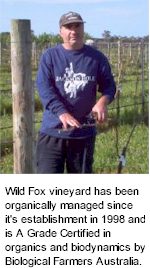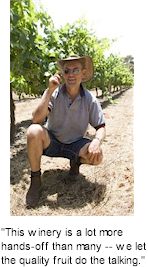| |
|
|

|
A single magnificent parcel of Pinot Noir vines
Planted To The Gravelly Lochar Soils Of A Rocky Knoll On Amisfield Block In Central Otago 1 The parched plantings send their roots deep into the inhospitable terrains struggling for water and yielding meagre harvests of the most intensely flavoured fruit.
|
|
|
|

|
Sparky Marquis is left handed
He Worked In Fine Restaurants As A Maitre D' To Pay His Way Through College Before returning to the family business of viticulture and establishing Mollydooker not far from the parents vineyards at the eminent Fox Creek. An inventory of parcels from Coppermine and Ryans Road, Martins and Long Gully Road, barrel fermented an matured in a high proportion of French and American oak. Awash with brambleberry, dark currants, plummyness and cerise, lingering on a course of soft chamois tannins.
|
|
|
|

|
Sauvignon Blanc in the way of the full bodied
Ageworthy Efforts From Bordeaux And Sancerre Oak treatments and a judicious term of age build palate texture while encouraging mouthfilling savouryness and sublime sauvage. Grapes are all hand picked and whole bunch pressed into four 600 litres, Rhône styled oak fermenting vats for ten days vinification and ten months on sediments, treated to the occasional lees stirring battonage before bottling in January. The big boned, well fleshed genre of Sauvignon Blanc which unlocks the fruity exterior and reveals the cornucopia of complexity within.
|
|

M3 CHARDONNAY IS SOURCED EXCLUSIVELY FROM A SINGLE SITE, the Shaw+Smith M3 property at Woodside, named after the three partners in the vineyard, brothers Michael and Matthew Hill Smith, along with cousin Martin Shaw. M3 is a major refinement in styling, a serious attempt to produce an exceptional Chardonnay with the capacity to age gracefully. A sophisticated, barrel fermented wine with pure fruit character and restrained oak, exhibiting great elegance and exquisite length. A must for all enthusiasts of stately white wine.

ONE OF THE EARLIEST COMMERCIAL WINEMAKING OPERATIONS EVER ESTABLISHED IN VICTORIA. Heathcote Winery can also boast some of the oldest Australian plantings of Viognier. The winery building dates back to 1854 when it serviced miners seeking their fortune in the heady days of the Victorian gold rush. Shiraz with a splash of Viognier is predominantly sourced from estate vineyards on the periphery of Heathcote township, harvested just when the chunky tannins, cherry acids, natural grape sugars and bold red Heathcote earth characters are at their peak.

ROSEMOUNT ESTATE IS ENJOYED THROUGHOUT THE WORLD, best known for its delicious white wines and distinctive Diamond Label. By blending components of the spicey Traminer with harvests of good Riesling, the Rosemount team have fashioned a richly flavoured and stylish young wine, suitably attired in a funky label that tells you it's Rounded & Zesty. This refreshing blend of fruits mates beautifuly with boldly flavoured recipes or ripe cheese. The essential easy drinking, fruit forward style for which Rosemount has became famous.

LECONFIELD OCCUPIES SOME OF THE COONAWARRA'S RICHEST TERRA ROSA OVER LIMESTONE SOILS, a composition that's idyllic for vintages of superior new world Shiraz. The aim is to craft a wine endowed with great palate depth and weight of fruit whilst retaining elegance, where oak complexes and enhances the fruit but is not allowed to dominate. Several components of Leconfield complete their fermentations in barrel while the balance is treated to extra time on skins before pressing and filling into the highest quality French oak for an extravagant, extended maturation.
|
Phillip Moraghan was
so captivated by the wines of France and Switzerland, so enthralled by Burgundy and its Pinot Noir, that he was inspired to establish Curly Flat Vineyard
Fortunately for Moraghan, his partner Jeni shared the vision that has brought together the dedicated team to nuture Curly Flat from a romantic ideal to awesome reality. Pursuit of the dream and a cool climate suited to Pinot Noir, brought Phillip and Jeni to Lancefield in the Macedon Ranges near Melbourne. The high altitude region is ideally suited to wine growing, with well drained volcanic soils and moderate rainfall. Curly Flat is located on a slope that catches the very last rays of sunshine in the magical moments before dusk. This prolonged exposure to the Autumn sun provides a vital ingredient for the very special fruit that is produced at Curly Flat. To build expertise Jeni and Phillip volunteered their labour in other vineyards and wineries - but it was Macedon Ranges pioneer, Laurie Williams (Flynn & Williams label), who nurtured their understanding and passion for growing wine.

Phillip began studying viticulture and travelling overseas to gain experience in wine growing and making, he has done several vintages in the USA, including Ponzi Vineyards in Willamette Valley Oregon and Russell Hearn's Premium Wine Group on Long Island NY. The first vines were planted at Curly Flat in 1991 and progressively added to, principally Pinot Noir with some Chardonnay and a little Pinot Gris. A new winery was constructed and the original homestead, built in 1890s, has been extensively renovated to host wine tastings and other wine related events. Prior to the 2002 vintage the wines were made at a neighbouring winery under contract, with equipment and labour input from the Curly Flat Team. In 2002 Phillip took over the winemaking role, under the guidance of one of Australia's leading winemakers who is a renowned Pinot Noir specialist.
The central focus of the entire Curly Flat operation is the vineyard. Philosophy is based on the belief that good and great wine is primarily a product of the vineyard, the site, the soil and how the viticulturalist manages all components of the vineyard. Annual and long term management practices and all decisions on variety, clones, rootstocks, trellis systems combine to produce the finest of wine grapes.
The choice of trellis systems sets Curly Flat apart from most vineyards. Divided trellis systems, particularly the Lyre, are more costly to construct and manage, thus rarely used. Only manual harvest is possible thereby greatly reducing its attraction to larger more commercial wine concerns. The vine canopy has two curtains of foliage, allowing sunshine inside the trellis walls to maximise exposure to sunlight, facilitating better ripening, improved wine colour, increased intensity of flavour and reduced plant disease risks.
In choice of vines, Curly Flat follows the European approach of selected multiple clones to gain increased complexity. To date Curly Flat has five clones of Pinot Noir and four of Chardonnay. Curly Flat was selected by the Victorian & Murray Valley Vine Improvement Association to be one of only two Victorian mothervine custodians of the most recently introduced Burgundy Pinot Noir clones, 114 and 115.
As in viticulture, education, training and experience are core to having the necessary skills to manage the growing and making of fine wines. Curly Flat vineyard is tended by a dedicated team of full time vineyard staff. Several are studying, or have completed, apprenticeships in Viticulture. The foundation of winery culture is the belief that it is the grapes from the vineyard that are the primary determinant of final wine quality. In essence, good wine comes from good fruit - the better the fruit, the more the winemaker becomes a custodian of nature's handiwork. Thus the winery culture at Curly Flat is one of guidance of the natural ingredients from the vine to wine, with minimal intervention. Nothing integrates the constituent parts of wine as well as Mother Nature. None of the fruit is actually crushed, Pinot Noir is a combination of whole bunch and de-stemmed fruit, while the Chardonnay is all whole bunch pressed. Both practices follow the traditional minimalist approach to these two classic varieties.
Producing the best
tasting, best quality organic wines for the good of our health and the environment is not a job, it is Wild Fox's passion
Established 1998 on Gawler River west of the Barossa Valley, Wild Fox vineyard has been true to the best biodynamic and organic farming practices to produce quality natural wine grapes to make award winning wines. All for the pleasure of the fine wine connoisseur and especially for those with allergies and or indifference to additives. It all began 70 years ago in the village known as Agrelopo, on the historic island of Chios Greece, where they farmed in tune with the cycles of the sun and the moon, coaxing the seasons, to achieve the ultimate nutrition in their produce from the soil, the sun and the rain. Biological farming is a phrase to describe biodynamic and organic farming. Both use innovative, non-chemical techniques for farming in harmony with the environment and providing nutrient rich, healthy soils from which healthy produce is grown.

Wild Fox are sourced from grapes grown to the cleanest vineyards under true practices and guidlines of certification. The estate vineyard has been organic since 1998 and is A Grade Certified in organics and biodynamics by the Biological Farmers of Australia. Motivating factors are twofold, caring for the health of the soil and caring for the long term health and sustainability of the environment, achieved only through sustainable Organic and Biodynamic farming practices. There are many articles on the benefits of Organic and bio-dynamic farming. Certification of Organic Wines is by adherence not only to a chemical free vineyard, but also in the winemaking and bottling of the wine. The vineyard, winery and even bottling premises need to adhere to strict certification criteria.
The vines are irrigated by natural water from the aquifers below, loamy soils, mediteranean style climate and natural practices formulate conditions to achieve high quality grapes. Wild Fox Wines enjoy status as one of the state's longest certifed and premium organic vineyards.
Canopies covering the hand pruned vines are managed to capture the sun's health giving rays while protecting fruit from spring and summer mildews and rusts. During the summer, vines are watered by drip irrigation from the natural underground aquifers.
Soils are cared for by growing cover crops in the mid rows to not only suppress weeds but to layer a mulch with slashing and rolling. This practice conserves moisture in the heat of the summer and also protects the activity of the soil's micro organisms. These practices have been supervised and documented by researcher, Chris Penfold of Adelaide University's Roseworthy Campus.
Grapes bursting with flavour and energy are the rewards of low yielding vines in a carefully managed natural environment. At the winery, strict documentation is followed to ensure protection of the certified product in meeting the criteria for Australian and American Organic Standards. Pristine fruit, picked at optimum ripeness is essential to the creation of Wild Fox, emerging with low sulphur levels for the comfort of those who may be sensitive even to the naturally occuring sulphur in wine. Only dedicated people will help make the Wild Fox story a successful one. All growers and staff are highly dedicated and committed to producing and promoting wines that respect, enhance and sustain our natural environment. Wild Fox are proud to make wines which are clean and pure, that taste great and carry health benefits.
The Rymill winery,
steeped in history, is situated within The Riddoch Run Vineyards at the northern end of the famous Terra Rossa strip
Coonawarra patriarch John Riddoch struck gold at the Ovens Valley goldfields in 1852, before establishing himself as a wholesale wine and general merchant in Geelong. He eventually settled near Penola, at shearing time in 1861. The Riddoch Run eventually expanded to 50,000ha, carrying 110,000 sheep and 3,000 cattle, and extended from Comaum in the north to Mt Gambier Airport in the south. During his subsequent four decades of community service Riddoch was Chairman of the Penola District Council for 25 years, and also the local Member of Parliament from 1865 to 1873, obtaining roads and education for the region. The Riddoch Highway and Mt Gambier's Riddoch Art Gallery currently commemorate his name.

John Riddoch's parliamentary endeavours eventually brought a railway to the South East, which revolutionised its social and economic development. He also introduced the Californian Pinus radiata to the district, thus initiating its forestry industry, and established a 20,000ha dairying enterprise at Glencoe. Most significantly, however, he subdivided his prime tract of terra rossa soil in 1890 to found the Penola Fruit Colony, which the independent and prosperous Colonists re-named Coonawarra in 1897, after the label of Riddoch's first vintage. His obituary in 1901 recognised him as The Father of the South East
John Riddoch Rymill, John Riddoch's grandson, was born at Penola Station in 1905 and studied accounting, anthropology, nutrition and surveying, and also learnt to ski and fly. In 1929, with his powerful 193cm (6'4") physique capable of carrying an 82kg (180lb) pack effortlessly, he joined a Cambridge University expedition mounted to study the interaction of the American Indians and Eskimos (Inuit) in northern Canada. Rymill next won a position as pilot and surveyor on the 1930-31 British Arctic Air Route Expedition, investigating the terrain and meteorology of Greenland beneath the proposed Great Circle air route between Britain and North America. The expedition culminated in his epic 700km crossing of the featureless 3,000m high Greenland Ice Cap with sledge and huskies.
Rymill's foremost achievement was, at the age of 29, to raise the necessary funds and lead the independent 1934-37 British Graham Land Expedition to the Antarctic. The expedition successfully surveyed over 1,000km of previously unexplored coastline, establishing that Graham Land was not an archipelago but, in fact, the Antarctic Peninsula. In 1938 John Rymill married Eleanor Francis who, having completed her Californian fieldwork at Berkeley, had just graduated as the first female PhD in Geography from Cambridge University. Arriving at Penola Station in 1939, Eleanor was soon managing the property while John served in the Navy during World War II. They then embarked upon innovative programs of perennial pasture development, and of breeding Corriedale sheep and Angus cattle. John Rymill was also keenly interested in equestrian sports, being instrumental in founding the Equestrian Federation of Australia and the Pony Club Association of SA.
Peter Riddoch Rymill, the elder son of John and Eleanor Rymill and great-grandson of the founder of Coonawarra winegrowing region John Riddoch, was born in 1940. A keen equestrian like his father, he competed in California and Ireland, retiring after he won the Australian Show Jumping Championship. He also studied Science at Adelaide University and, on his return to Old Penola Station, successfully applied genetics to establish a distinctive and lucrative composite breed of cattle. After Peter married international Three Day Eventer and Show Jumper Judy Ritchie in 1964, horses continued to play an integral role in their competitive and farming lives.
Peter and Judy diversified into viticulture in 1968 with an experimental vineyard, and six years later the family enterprise returned to Coonawarra when The Riddoch Run Vineyards were planted. While Judy managed the farm, Peter completed a degree in Wine Science and a diploma in Wine Marketing before he began building this winery in 1990. Here the vision so characteristic of his great-grandfather, John Riddoch, and his father, John Rymill, is evident. And now, with a new generation already involved, the Riddoch Rymill family tradition continues.
Despite a history
of little more than a decade, Fermoy Estate's wines have won acclaim which belies the vineyard's youth
The property takes its name from the town of Fermoy, Co. Cork. Ireland which was founded by an ancestor of one of the original owners.

Its Cabernet Sauvignon scooped a Gold Sheraton wine award within its first year of production and its Merlot and Semillon have also been hailed at both wine shows and in the marketplace. The vineyard was established in 1985, and completed its first vintage in 1988. A total of 14 hectares is now planted which in full production should yield around 160 tonnes of premium fruit.
The winery was built in 1987 to the specifications of the Winemaker Michael Kelly, and has since been expanded to accommodate Fermoy Estate's dynamic growth from 120 cases at first vintage to more than 10,000 cases annually. While Fermoy Estate incorporates leading edge technology, it retains many Old World traditions. The vines are hand-pruned and hand-picked, and by careful fruit selection Fermoy is able to craft distinctive table wines full of unique flavours and characters.
Celebrated Sydney restaurateur Neil Perry cites Fermoy's Michael Kelly on his list of best Australian winemakers
Such high praise is acknowledged by Michael with characteristic modesty. He is happier pressing grapes than pressing the flesh at glamorous restaurant openings. But with dirt in his veins, it was almost inevitable that his career path led him to the rich soils and verdant vines of Margaret River wine country. A fourth generation farmer, his introduction to the wine industry was in 1980 when he was employed by Dr John Middleton at his Mount Mary vineyard in the Yarra Valley, Victoria.
A degree in wine science followed, a course which included a vintage at Domaine Louis Chapuis in the Burgundy region of France.After completing his education he returned to Western Australia and worked at Sandalford, Leeuwin Estate, and on the retail side of the business, before joining Fermoy Estate in 1987. Michael believes that the wines are only ever as good as their ingredients and consequently much effort is lavished on the Fermoy vineyards in the quest for prime quality grapes.
The ten hectare vineyard was planted in 1985, the main varieties being cabernet sauvignon and semillon with smaller parcels of sauvignon blanc, chardonnay, merlot and chenin blanc. The useful blending varieties of malbec and cabernet franc are also grown. To cope with the increasing demand for our products, the vineyard was expanded in 1995 by another 4 hectares. These vines will come on stream for vintage 2000, with an expected total yield of around 160 tonnes.
|